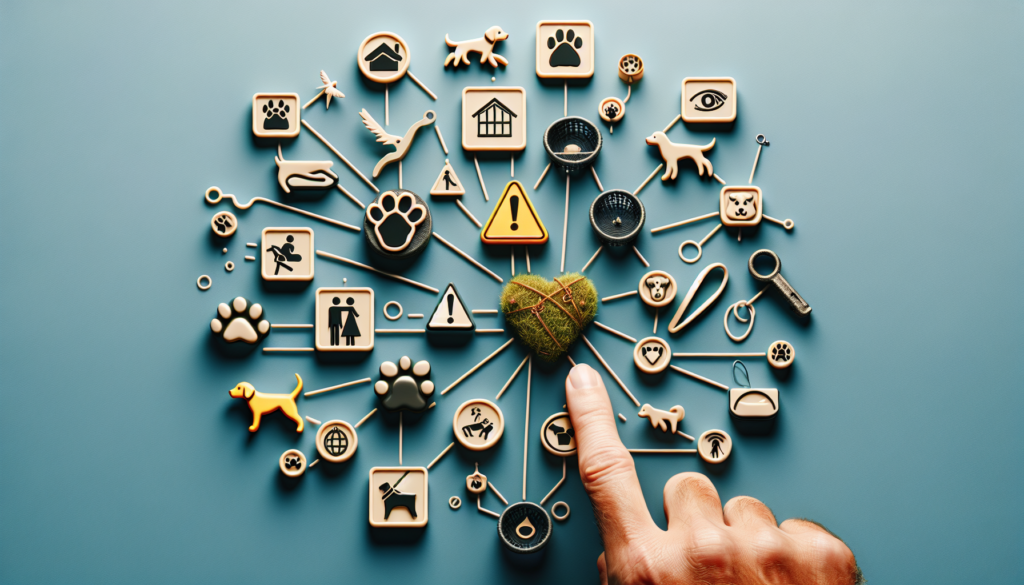Are you a dog lover? If so, it’s essential to understand the importance of preventing dog bites not only for your own safety but also for the well-being of these lovable creatures. In this article, we will explore the reasons behind dog bites, providing you with valuable insights to help you maintain a harmonious relationship with our furry friends. With a deeper understanding of their behavior and the proper prevention techniques, you can ensure a safer and more enjoyable experience for both you and your four-legged companion.

Understanding Dog Behavior
Canine communication
Understanding how dogs communicate is essential in preventing dog bites. Dogs use various forms of communication to express their emotions and intentions. They communicate through body language, vocalizations, and facial expressions. By learning to interpret their signals, you can better understand their behavior and respond appropriately.
Territorial behavior
Many dogs exhibit territorial behavior, which involves protecting their environment or possessions. This behavior can be triggered when someone enters their territory, such as their home or yard. It’s important to respect a dog’s space and avoid approaching them if they are displaying signs of territorial aggression.
Protective behavior
Dogs may display protective behavior towards their owners, family members, or even their possessions. This behavior is driven by their natural instinct to guard and protect. It’s crucial to recognize the signs of protective behavior and avoid triggering aggressive responses. Proper training and socialization can help prevent excessive protective behavior.
Fear and anxiety
Fear and anxiety can greatly influence a dog’s behavior and increase the risk of aggression. Dogs may become fearful or anxious in various situations, including encountering strangers, loud noises, or unfamiliar environments. Understanding the triggers that cause fear and anxiety in dogs can help you avoid potential confrontations and ensure their well-being.
Triggering factors
Several factors can trigger aggressive behavior in dogs, including provocation, resource guarding, pain, fear, and territoriality. Recognizing these triggering factors can help you better understand your dog’s behavior and take necessary precautions to prevent aggressive incidents.
Recognizing warning signs
It’s crucial to be able to recognize the warning signs that a dog may exhibit before becoming aggressive. These signs may include growling, snarling, baring teeth, raised hackles, intense staring, and stiff body posture. By identifying these warning signs, you can take proactive measures to de-escalate a potentially aggressive situation.
Understanding body language
Dogs communicate a significant amount of information through their body language. Key indicators of their emotional state include the position of their ears, the posture of their body, the movement of their tail, and their overall demeanor. By becoming familiar with the various body language cues, you can better understand a dog’s intentions and respond accordingly.
Breeds and Bite Statistics
Dog breeds with higher bite rates
While it’s important to note that any breed of dog can potentially bite, certain breeds have been statistically more likely to be involved in bite incidents. Breeds such as Pit Bulls, Rottweilers, German Shepherds, and Doberman Pinschers are often associated with higher bite rates. However, it’s crucial to remember that these statistics do not reflect the behavior of all individuals within a breed.
Small vs. large breeds
Contrary to popular belief, the size of a dog does not necessarily correlate with its tendency to bite. Both small and large breeds can exhibit aggressive behavior, and individual temperament should be the primary consideration when evaluating a dog’s potential for aggression. Responsible ownership and proper training play a more significant role in preventing dog bites than breed alone.
Factors affecting breed behavior
Breed behavior can be influenced by factors such as genetics, socialization, training, and individual temperament. While certain breeds may have a predisposition towards certain behaviors, it’s crucial to recognize that these factors are intertwined and can vary widely within a breed. Proper socialization, training, and responsible ownership are essential for all breeds.
Common misconceptions
There are several common misconceptions surrounding dog behavior and breeds. One common myth is that aggressive behavior is solely dependent on breed, disregarding the individual dog’s experiences and environment. Another misconception is that all rescue dogs are aggressive or dangerous. These misconceptions contribute to stereotypes and can hinder efforts to prevent dog bites.
Socializing and Training
The importance of socializing puppies
Socialization is a critical aspect of raising a well-behaved and non-aggressive dog. Early and positive experiences with people, other animals, and various environments during a puppy’s sensitive period help them develop social skills and reduce the likelihood of aggressive behavior later in life. Puppy socialization classes and supervised exposure to different stimuli are essential for proper socialization.
Positive reinforcement training
Positive reinforcement training is a highly effective and humane method of training dogs. This training technique involves rewarding desired behaviors and ignoring or redirecting unwanted behaviors. By focusing on positive reinforcement, you can foster good behavior and build a strong bond of trust and communication with your dog.
Fostering good behavior
Setting clear expectations and consistently reinforcing good behavior is essential in preventing aggressive behavior. Rewarding desired behaviors such as sitting, staying, and gentle play helps reinforce positive actions. Consistency, patience, and positive reinforcement are key factors in fostering good behavior in dogs.
Correcting aggressive behavior
When dealing with aggressive behavior, it’s important to approach it with caution and seek guidance from professional trainers or behaviorists. Correcting aggressive behavior should focus on positive reinforcement, desensitization, and counterconditioning techniques. Implementing training methods that address the root cause of aggression and establishing clear boundaries can help modify aggressive behavior.
Working with professional trainers
If you are struggling with your dog’s behavior or aggression issues, seeking help from professional trainers or behaviorists can be highly beneficial. These experts can assess your dog’s behavior, provide specialized training techniques, and assist in developing a management plan. Professional guidance ensures that you employ effective and safe methods in dealing with aggression.
Supervision and Interaction
Supervising children and dogs
Child-dog interactions should always be closely supervised to prevent potential dog bites. Children may unintentionally provoke a dog or engage in rough play that can trigger aggressive behavior. It’s crucial for adults to actively supervise and intervene in interactions to ensure the safety of both the child and the dog.
Teaching children proper dog interaction
Educating children on how to interact safely and respectfully with dogs is paramount in preventing dog bites. Teaching children to approach dogs calmly, ask for permission before petting, and avoid touching sensitive areas can help minimize the risk of aggression. Children should understand that not all dogs are friendly and that they should never approach unfamiliar dogs without adult supervision.
Recognizing when a dog is overwhelmed
Dogs may display signs of being overwhelmed or stressed when in certain situations, such as crowded environments or when approached by multiple people. These signs may include panting, yawning, avoiding eye contact, or trying to escape. Recognizing when a dog is overwhelmed and removing them from stressful situations is crucial to prevent aggressive behavior.
Establishing boundaries and rules
Setting clear boundaries and rules for both children and dogs is essential in preventing dog bites. Dogs should have designated areas in the house where they can retreat to and feel safe. Children should be taught to respect a dog’s space and understand the appropriate times to interact with them. Consistency in enforcing boundaries and rules helps establish a harmonious environment.
Enforcing safe play
Play is a crucial aspect of a dog’s life, but it’s essential to ensure that play remains safe and appropriate. Dogs may exhibit rough play behavior, such as biting or jumping aggressively, which should be discouraged. Encouraging gentle play, redirecting inappropriate behavior, and providing appropriate toys and activities can help prevent escalation into aggression.

Proper Care and Enclosures
Providing adequate exercise
Regular exercise is essential for a dog’s physical and mental well-being. Insufficient exercise can lead to pent-up energy and frustration, increasing the likelihood of aggressive behavior. Providing daily exercise, such as walks, playtime, and mental stimulation, helps fulfill a dog’s needs and promotes a calmer and well-behaved demeanor.
Healthcare and regular vet visits
Maintaining a dog’s health through regular vet visits and proper healthcare is crucial in preventing aggressive behavior. Illnesses, injuries, or untreated pain can contribute to changes in behavior and increase the risk of aggression. Regular check-ups, vaccinations, and prompt treatment of any health issues are essential for a dog’s overall well-being.
Spaying/neutering
Spaying/neutering your dog can have a positive impact on their behavior and reduce the risk of aggression. Spaying/neutering helps decrease the hormonal drive that can contribute to territorial and protective behavior. It also reduces the likelihood of certain health problems and unwanted behaviors associated with intact dogs.
Secure fencing and containment
Properly securing your property with a secure fence or enclosure is essential in preventing dog bites. Dogs should have a safe and contained area where they can play and exercise without the risk of escaping or encountering strangers. Ensuring that fences are in good condition and gates are secure helps prevent potential accidents and incidents.
Properly restraining dogs
Properly restraining dogs, especially in public settings, is crucial in preventing dog bites. Using a sturdy leash and harness or a secure crate can ensure that dogs are under control and unable to approach others in a threatening manner. Following leash laws and respecting public spaces helps create a safe environment for everyone.
Preventing Aggressive Behaviors
Avoiding confrontational training methods
Using confrontational training methods, such as alpha rolls, physical punishment, or shock collars, can lead to aggressive behaviors in dogs. These methods create fear and anxiety, which may result in defensive aggression. Positive reinforcement-based training methods that focus on rewarding desired behaviors are more effective and humane.
Preventing resource guarding
Some dogs exhibit resource guarding behavior, which involves protecting their food, toys, or other possessions from perceived threats. Preventing resource guarding requires early intervention and proper training. Teaching dogs to associate positive experiences with people approaching their resources and using reward-based training can help minimize resource guarding behavior.
Managing food aggression
Food aggression can pose a significant risk, especially in multi-dog households or when children are present. Preventing food aggression involves providing separate feeding areas, feeding dogs at a safe distance from one another, and gradually conditioning dogs to tolerate proximity during feeding time. Seeking professional guidance may be necessary in severe cases of food aggression.
Addressing possessive behavior
Dogs may exhibit possessive behavior towards objects, people, or areas. Addressing possessive behavior requires teaching dogs the concept of sharing and gradually exposing them to situations where they must relinquish objects or interact with others. Positive reinforcement, desensitization, and counterconditioning techniques can help modify possessive behavior.
Limiting rough play
Rough play can escalate into aggression if not properly managed. Establishing boundaries and rules for playtime helps prevent dogs from becoming overly excited and potentially aggressive. Providing appropriate toys, redirecting inappropriate behavior, and teaching the “leave it” command are effective strategies for limiting rough play.
Educating the Community
Raising awareness about dog bite prevention
Educating the community about dog bite prevention is crucial in reducing the number of dog-related incidents. Public awareness campaigns, educational materials, and community programs can help disseminate information on responsible dog ownership, proper training techniques, and recognizing potential warning signs.
Teaching responsible dog ownership
Promoting responsible dog ownership is an essential step in preventing dog bites. This includes educating owners on the importance of socialization, training, proper healthcare, and providing a safe environment for their dogs. Responsible owners should prioritize their dog’s well-being, understand their needs, and take necessary precautions to prevent aggressive behavior.
Educating children about dog safety
Teaching children about dog safety is vital in reducing the risk of dog bites. Schools, community organizations, and parents can actively participate in educating children on how to approach dogs, read their body language, and understand the appropriate ways to interact with them. This knowledge empowers children to make informed decisions and avoid potential dog-related accidents.
Promoting empathy and respect for animals
Promoting empathy and respect for animals helps foster a culture of responsible dog ownership and reduces the likelihood of aggressive incidents. Teaching children and adults to treat animals with kindness, compassion, and respect enhances their understanding of dogs’ needs and encourages responsible behavior towards pets.
Organizing community events and seminars
Organizing community events, seminars, or workshops on dog behavior, training, and bite prevention can be highly beneficial. These events provide a platform for experts to share their knowledge, address common concerns, and engage with the community. Attendees can learn valuable strategies and techniques to prevent dog bites and promote a safer community.
Handling Encounters with Unknown Dogs
Approaching unfamiliar dogs safely
Approaching unfamiliar dogs should be done cautiously to minimize the risk of aggression. It’s essential to seek permission from the owner before attempting to interact with a dog. Approach slowly, avoid direct eye contact, and extend a closed hand for the dog to sniff. Reading the dog’s body language and responding accordingly is crucial in safely approaching unknown dogs.
Reading signs of aggression
Being able to recognize the signs of aggression in an unknown dog is essential for personal safety. Signs may include bared teeth, growling, raised hackles, a stiff body posture, or intense staring. If a dog displays these signs, it’s important to slowly and calmly back away without turning your back or making sudden movements.
Reacting if a dog approaches aggressively
If a dog approaches aggressively, it’s crucial to remain calm and avoid provoking the dog further. Stand still, avoid eye contact, and keep your hands and arms close to your body. Speaking softly and using soothing tones may help diffuse the situation. If the dog attacks, protecting vital areas of your body, such as your neck and face, becomes a priority.
Using self-defense techniques
In rare cases when there is no other option, using self-defense techniques can help protect yourself from an aggressive dog. Techniques such as using a jacket or bag as a barrier, using an object to distract or deter the dog, or creating distance by climbing onto an object can be effective. However, self-defense should always be a last resort.
Reporting aggressive dogs
If you encounter an aggressive dog in a public space, it’s crucial to report the incident to the appropriate authorities, such as animal control or the local police. Reporting aggressive dogs helps create awareness and allows authorities to investigate and address potential safety concerns. Providing accurate details of the dog’s appearance and location is important for a thorough investigation.
Bite First Aid and Medical Care
Immediate actions after a dog bite
After a dog bite, it’s important to take immediate actions to ensure personal safety and prevent infection. Wash the wound thoroughly with soap and warm water, gently pat it dry, and cover it with a clean bandage. Applying an antiseptic ointment and elevating the affected area can help minimize the risk of infection.
Cleaning and caring for the wound
Properly cleaning and caring for a dog bite wound is crucial in preventing complications. Rinse the wound with running water, clean it with mild soap, and apply an antiseptic solution or cream. Cover the wound with a sterile bandage and change it regularly to foster healing. Seek medical attention for deep, puncture, or heavily bleeding wounds.
When to seek medical attention
Not all dog bites require immediate medical attention, but some situations warrant professional evaluation. Seek medical attention if the bite is deep, bleeding heavily, or shows signs of infection, such as increasing redness, swelling, warmth, or pus. Additionally, medical attention should be sought for bites on the face, hands, or genital areas due to the higher risk of complications.
Rabies and tetanus considerations
After a dog bite, it’s important to consider the risk of rabies and tetanus. If the dog’s vaccination status is unknown or it displays abnormal behavior, consulting a healthcare provider to evaluate the need for rabies prophylaxis is essential. Tetanus vaccination may also be necessary if the wound is deep or contaminated.
Emotional support after an incident
Experiencing a dog bite can be a traumatic event, and emotional support is crucial for recovery. Reach out to friends, family, or support groups to share your experience and seek guidance. Counseling or therapy may be beneficial in processing the emotional impact of the incident and developing strategies to manage any fear or anxiety that may arise.
Legal and Liability Issues
Dog bite laws and regulations
Dog bite laws and regulations can vary depending on the jurisdiction. It’s important to familiarize yourself with the local laws regarding dog bites, liability, and reporting requirements. Understanding your rights and responsibilities as a dog owner or victim of a dog bite can help navigate legal matters more effectively.
Liability of dog owners
In many jurisdictions, dog owners can be held liable for injuries or damages caused by their dogs. Owners are responsible for properly restraining their dogs, preventing aggressive behavior, and complying with local regulations. If a dog owner fails to fulfill these responsibilities, they may be held legally accountable for the consequences of their dog’s actions.
Suing for damages
In severe cases of dog bites, victims may pursue legal action to seek compensation for damages. These damages may include medical expenses, lost wages, pain and suffering, and emotional distress. Consulting with a lawyer specializing in dog bite cases can help victims understand their options and navigate the legal process.
Insurance coverage for dog bites
Homeowners’ insurance policies often provide coverage for dog bites and related injuries. It’s important to review your insurance policy to understand the extent of the coverage and any exclusions or limitations. Insurance companies may have specific requirements for dog breeds with a history of aggression or prior bite incidents.
Consequences of negligence
Negligence on the part of dog owners can have serious consequences. Failing to properly train, socialize, or restrain a dog can result in aggression and potential harm to others. Additionally, owners who disregard local regulations or fail to take necessary precautions may face legal and financial ramifications if their dog bites or injures someone.

